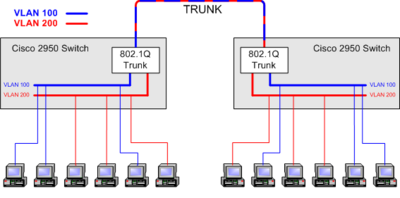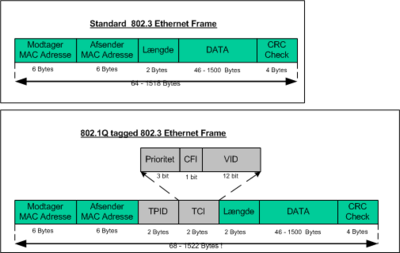IEEE 802.1Q
The IEEE 802.1Q trunk protocol connects two or more Ethernet or Token Ring switches, and allows transmission of packets between Switches sharing the same VLAN(s).
Principle
In figure 1 all PC's connected to ports which are in VLAN 100 - Blue - can communicate together, and all PC's connected to ports in VLAN 200 - Red - can communicate together. In figure 1 there can be no exchange of frames between VLAN 100 and VLAN 200.
Why is a trunk protocol needed
A trunk protocol is needed when using a OSI layer 2 technology as Ethernet or Token Ring because the Layer 2 header has no field describing the origin of the frames. Se figure two upper half Standard 802.3 Ethernet Frame. There is no field where the transmitting Switch can tell the receiving Switch which VLAN a receiving frame belongs.
Tagging a Frame
If both switches uses the IEEE 802.1Q tagging trunk protocol, the transmitting Switch tags the frame when sending it. Se figure 2 bottom half 802.1Q tagged 802.3 Ethernet Frame
| Field | Description |
|---|---|
| Priority | Also called COS field or Class Of Service. A priority between 0 and 7 |
| CFI | Canonical Field Indicator CFI=0 (Ethernet) CFI=1 (Token Ring) |
| VID | Vlan ID, to which VLAN number the Frame belongs (0 - 4095) |
Native VLAN
Defined in the 802.1Q specification there is one untagged VLAN. The standard untagged VLAN for ethernet is VLAN 1 which is the standard administrative VLAN. All ethernet ports belong to VLAN 1 on a unconfigured switch.

